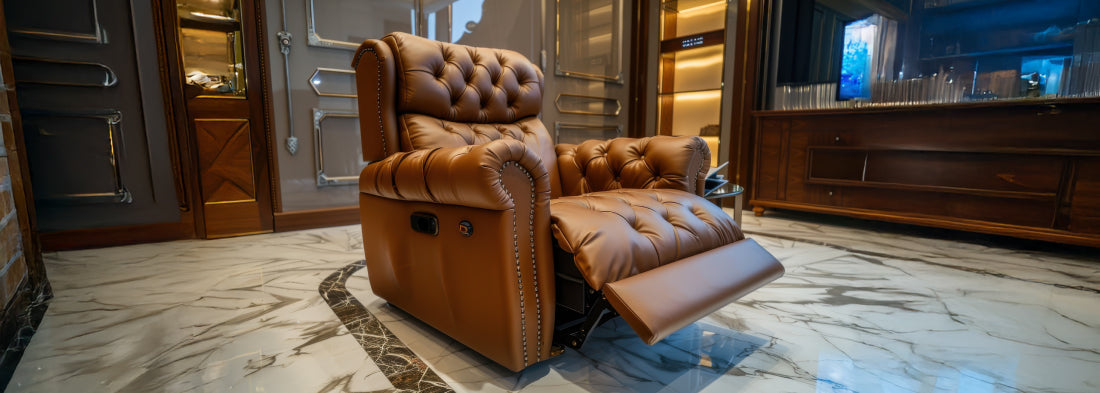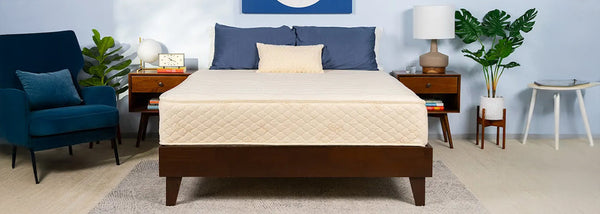Do Recliner Sofas Damage Your Flooring?

Recliner sofas are prized for their unbeatable comfort, advanced ergonomics, and ability to elevate the home lounging experience. Whether it’s a Recliner Sofa for movie nights, a cozy corner for reading, or a centerpiece in your living room, their popularity continues to rise in modern homes. They provide multifunctional support and comfort that caters to people of all ages, especially those with mobility concerns or who spend long hours seated. With the availability of both manual and Motorized Recliners, options now extend from basic lounging to therapeutic and tech-savvy relaxation experiences.
But as you consider introducing one into your space, a practical concern often arises: Do Recliners Scratch Floors? This question becomes especially relevant when you're investing in premium flooring materials like hardwood, marble, or luxury vinyl that require long-term care and protection. Aesthetic appeal and functionality should go hand in hand, and the last thing any homeowner wants is to damage their flooring investment with the wrong furniture setup.
Understanding the interaction between recliner sofas and your flooring is critical. From how different recliner base designs affect surface pressure to how often you reposition the unit, several variables play a role in maintaining the integrity of your floors. This blog explores everything you need to know—from identifying the Best Flooring for Recliner Sofas to implementing proven strategies on How to Protect Floors from Sofas—so you can enjoy luxurious comfort without compromising your interiors.
Do Recliners Scratch Floors?
This is one of the most frequently asked questions by homeowners. The answer depends on a variety of factors, including the type of recliner, the flooring material, the recliner base design, and how often the recliner is used or moved. Each of these elements contributes to whether your recliner setup will be floor-friendly or lead to long-term wear and tear.
Most recliner sofas, especially those with metal frames or exposed mechanisms, can potentially scratch or scuff flooring over time. This risk increases if the recliner is dragged or repositioned frequently, especially during cleaning or room rearrangements. Floors like polished wood, laminate, or vinyl are particularly vulnerable to scratches from sharp or heavy recliner legs or gliding mechanisms. Even small shifts during reclining can create repetitive stress points that gradually dull the surface finish or leave behind subtle grooves.
Additionally, Motorized Recliners or models with complex moving parts may shift slightly during use, increasing the risk of friction between the base and the floor. Since motorized options often feature weightier builds, the pressure exerted on sensitive floors is also higher. Therefore, it’s essential to understand how recliner movement, construction weight, and base design influence your flooring’s condition. Taking steps to minimize direct contact or pressure can significantly extend the life and appearance of your floors, especially when using heavier or frequently adjusted recliners.
Best Flooring for Recliner Sofas
Choosing the Best Flooring for Recliner Sofas involves finding a balance between style, durability, and resistance to wear and tear. Hardwood floors add warmth and elegance to any space and remain a popular choice among homeowners. However, they are more prone to visible scratches and dents, especially when heavy furniture like a recliner is placed directly on top. For this reason, it's advisable to pair hardwood with protective mats or pads when installing a recliner.
In contrast, luxury vinyl and laminate flooring are more scratch-resistant, affordable, and easy to maintain. These materials provide a good foundation for recliners because they are resilient and less likely to show minor wear caused by recliner movements. They also offer versatility in design and color, helping match various interior styles.
Tile is another excellent option due to its hard, durable surface. It resists scratches well but can be susceptible to cracks or chips if the recliner is dragged or has a sharp base. Using protective padding beneath recliner bases on tile flooring is strongly recommended to avoid accidental damage. Carpeted flooring, on the other hand, offers a natural cushion against furniture movement and adds warmth to the room. While it reduces the risk of scratches entirely, it may compromise the reclining mechanism’s balance or movement, especially on thick or plush carpets.
Ultimately, selecting the Best Flooring for Recliner Sofas should factor in not just appearance but the functional interplay between furniture and flooring to ensure long-term satisfaction and minimal maintenance.

How to Protect Floors from Sofas
One of the best ways to ensure your flooring remains intact is by using felt pads, rubber cups, or furniture glides under your Recliner Sofa. These inexpensive accessories create a buffer between the sofa and the floor, minimizing friction, vibration, and impact. They are especially valuable if your recliner is frequently used or adjusted, as they help prevent wear patterns or scratches from forming over time. In addition to this, they make it easier to reposition the sofa without lifting, reducing the physical effort required and the potential for accidental dragging.
For added security, you can place area rugs or mats beneath your recliner—especially useful for hardwood or tile floors. These act as a secondary layer of protection and can even enhance the aesthetic appeal of your living room. Choose low-pile rugs for minimal interference with the recliner’s movement or select ones with a non-slip backing to ensure stability.
Another key aspect is regular maintenance. Dirt and debris trapped under recliner legs can act like sandpaper, grinding into the floor with every movement. This abrasive effect, though subtle, accumulates over time and may result in dull spots or visible scratches. Sweeping or vacuuming beneath and around the recliner frequently can help reduce this risk and maintain the shine and smoothness of your flooring. Periodic inspection of the recliner’s feet or base for signs of wear, sharp edges, or dislodged pads can also prevent unexpected damage and ensure your setup remains floor-friendly in the long term.
Do Recliners Scratch Floors? (Revisited)
To prevent long-term flooring damage, be mindful of how your recliner is used daily. Avoid dragging it across the floor—this is one of the most common causes of scratches and scuffs. Instead, lift or gently shift the recliner when needed, and make sure that any motion mechanisms, such as footrests and reclining levers, are functioning smoothly to reduce unexpected movement. Regularly inspect the recliner base for sharp edges, protruding parts, or worn protective pads, as even minor imperfections can cause cumulative floor damage over time.
Recliners with flat, broad bases tend to distribute weight more evenly, reducing the chance of creating pressure points that leave permanent marks or dents. This design minimizes the risk of indentation on softer flooring materials and is ideal for maintaining even wear on surfaces like hardwood and vinyl.
Sofa Legs vs Flat Base Sofas
The design of the recliner’s base plays a crucial role in its impact on your flooring. In the debate of Sofa Legs vs Flat Base Sofas, both options have distinct advantages and drawbacks. Recliners with sofa legs offer better airflow underneath, which can help with temperature regulation and make cleaning underneath easier. However, these legs often concentrate weight on small surface areas, increasing the chance of dents, scratches, or even cracks on more delicate flooring.
Flat base sofas, on the other hand, spread the weight of the recliner more evenly across a broader surface. This makes them gentler on sensitive flooring types such as softwood or laminate and can prevent deep pressure impressions. The downside is that flat bases can accumulate dust underneath and may require more effort to clean around, particularly if the sofa is heavy or motorized.
Motorized Recliners or heavy-duty recliners often use flat bases for better support and stability. Because these recliners tend to weigh more and include moving parts, the broader base adds an extra layer of protection to floors while ensuring structural integrity and reducing the chances of sudden tipping or unbalanced movement. Choosing the right base style not only enhances the comfort and usability of your recliner but also plays a significant role in preserving your floor’s aesthetic and physical condition.
Best Practices: How to Protect Floors from Sofas
Here are a few additional strategies to protect your flooring investment:
- Use area rugs or mats underneath your recliner to distribute weight and absorb shock. These also help absorb vibrations during reclining and prevent furniture from shifting out of place.
- Opt for recliners with padded or rounded legs to prevent sharp edges from digging into the floor. This is particularly important for hardwood or laminate surfaces, where even minimal pressure can leave marks over time.
- Install protective caps or sliders on sofa legs or base corners to reduce friction. These add-ons make it easier to reposition the recliner and shield delicate flooring from scraping damage during movement.
- Clean the area frequently to remove debris, which can act as an abrasive layer under pressure. Even small particles like dust or sand can grind into flooring finishes with repeated motion, so routine cleaning is key.
- Place recliners in low-traffic zones to reduce excessive movement and minimize wear patterns. Limiting frequent shifting or bumping helps maintain the integrity of both the floor and the recliner’s base over time.
Each of these precautions enhances the longevity of your flooring while preserving the comfort and functionality of your recliner.
These simple habits can dramatically reduce the chances of scratches and help maintain your floor’s pristine condition for years to come, ensuring that both your recliner and your interior space remain in excellent shape.
Do Recliners Scratch Floors? (Final Thought)
While the possibility exists, the risk can be mitigated with the right precautions. Understanding your recliner’s base type and choosing appropriate flooring materials are the first steps. Recliners with flat, broad bases tend to be more floor-friendly, while sofa legs can sometimes create concentrated pressure points. Once you've determined the best fit for your floor, reinforce that choice with accessories like felt pads, sliders, or area rugs to minimize contact friction.
Supplement these protective measures with regular maintenance—such as cleaning debris that can act as an abrasive, and inspecting the recliner's feet or motion parts for damage—to ensure your floor remains pristine. By being proactive about how your recliner interacts with the floor, you can significantly extend both the beauty of your flooring and the functional life of your recliner.
Conclusion: Balance Comfort and Care
Investing in a Recliner Sofa should bring relaxation, not stress. These pieces are designed to elevate comfort in your home, but without the right precautions, they could unintentionally compromise the aesthetics and durability of your flooring. Fortunately, with some thoughtful planning and proactive care, it’s entirely possible to enjoy a recliner’s luxurious features without worrying about scratches, dents, or shifting.
From selecting the Best Flooring for Recliner Sofas that can withstand daily wear to integrating small but impactful adjustments like felt pads or area rugs, each step makes a noticeable difference. Knowing How to Protect Floors from Sofas also empowers you to maintain your living space’s appeal while enhancing your lounging experience. With consistent maintenance and awareness of how your recliner interacts with its surroundings, you can achieve both comfort and confidence in your home setup. After all, a well-placed recliner should offer both luxury and peace of mind—without the trade-off.







